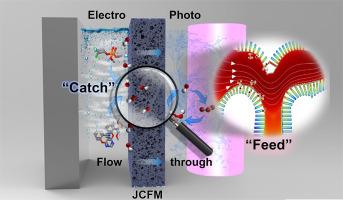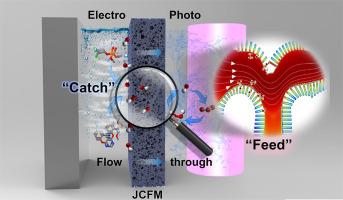“Catch-and-feed”: Janus catalytic flow-through membrane enables highly efficient removal of micropollutants in water
IF 11.4
1区 环境科学与生态学
Q1 ENGINEERING, ENVIRONMENTAL
引用次数: 0
Abstract
Micropollutants, due to their low concentrations, exceptional chemical stability, and profound toxicity, present a significant challenge in water treatment. While electrocatalysis and photocatalysis have shown promise as potential water purification techniques, their inherent limitations in mass transfer often result in elevated energy requirements and suboptimal efficiency. In this study, a Janus catalytic flow-through membrane (JCFM) was utilized to successfully remove two notorious micropollutants dichlorvos (DDVP) and azoxystrobin (AZX) from water based on the "catch-and-feed" strategy. This membrane adopts a ``sandwich'' configuration, comprising platinum-modified reduced titanium (Pt@rTO) as the electrocatalytic layer, porous titanium (Ti) as the current collector, and rTO as the photocatalytic layer. The JCFM exhibited remarkable performance, maintaining an •OH energy conversion efficiency of up to 20.12 nM and displaying catalytic activity (kJCFM = 6.97 × 10−4 s−1) in degrading AZX far superior to that of photocatalysis (kPC = 9.51 × 10−5 s−1) or electrocatalysis (kEC = 9.89 × 10−5 s−1) alone. It is evidenced that the Pt@rTO layer efficiently generates reactive oxygen species (ROS), which, along with the micropollutants, flow through the JCFM (“feed”), which strengthens mass transfer and facilitates efficient reactions within the confined space (“catch”). The ROSs then seep through the rTO layer, where they are reactivated by UV light radiation. The mechanism and the alternative reaction pathway of DDVP and AZX has also been proposed. In sequential testing, the JCFM achieved continuous and energy-efficient removal of micropollutants, exceeding 97.5 % over 200 h. The scale-up application of this technology has proven effective in the treatment of secondary biochemical effluent from municipal sewage, coking wastewater, and landfill leachate, achieving the concurrent degradation of various micropollutants.


"捕捉和喂养":Janus 催化直流膜可高效去除水中的微污染物
微污染物浓度低、化学稳定性强、毒性大,给水处理带来了巨大挑战。虽然电催化和光催化有望成为潜在的水净化技术,但它们在传质方面的固有局限性往往导致能源需求增加和效率不理想。在这项研究中,利用 Janus 催化直流膜(JCFM),基于 "捕捉-进给 "策略,成功去除了水中两种臭名昭著的微污染物敌敌畏(DDVP)和唑啉草酯(AZX)。这种膜采用了 "三明治 "结构,包括作为电催化层的铂改性还原钛(Pt@rTO)、作为集流器的多孔钛(Ti)和作为光催化层的 rTO。JCFM 表现出卓越的性能,在降解 AZX 的过程中能保持高达 20.12 nM 的 -OH 能量转换效率,其催化活性(kJCFM=6.97 × 10-4 s-1)远高于光催化(kPC=9.51 × 10-5 s-1)或电催化(kEC=9.89 × 10-5 s-1)。事实证明,Pt@rTO 层能有效生成活性氧(ROS),这些活性氧与微污染物一起流经 JCFM("进料"),从而加强了传质,促进了密闭空间("捕获")内的高效反应。然后,ROS 渗过 rTO 层,在紫外线辐射下被重新激活。此外,还提出了 DDVP 和 AZX 的机理和替代反应途径。在连续测试中,JCFM 实现了连续、节能地去除微污染物,在 200 小时内去除率超过 97.5%。该技术的放大应用已在城市污水、焦化废水和垃圾填埋场渗滤液的二级生化废水处理中证明是有效的,实现了各种微污染物的同时降解。
本文章由计算机程序翻译,如有差异,请以英文原文为准。
求助全文
约1分钟内获得全文
求助全文
来源期刊

Water Research
环境科学-工程:环境
CiteScore
20.80
自引率
9.40%
发文量
1307
审稿时长
38 days
期刊介绍:
Water Research, along with its open access companion journal Water Research X, serves as a platform for publishing original research papers covering various aspects of the science and technology related to the anthropogenic water cycle, water quality, and its management worldwide. The audience targeted by the journal comprises biologists, chemical engineers, chemists, civil engineers, environmental engineers, limnologists, and microbiologists. The scope of the journal include:
•Treatment processes for water and wastewaters (municipal, agricultural, industrial, and on-site treatment), including resource recovery and residuals management;
•Urban hydrology including sewer systems, stormwater management, and green infrastructure;
•Drinking water treatment and distribution;
•Potable and non-potable water reuse;
•Sanitation, public health, and risk assessment;
•Anaerobic digestion, solid and hazardous waste management, including source characterization and the effects and control of leachates and gaseous emissions;
•Contaminants (chemical, microbial, anthropogenic particles such as nanoparticles or microplastics) and related water quality sensing, monitoring, fate, and assessment;
•Anthropogenic impacts on inland, tidal, coastal and urban waters, focusing on surface and ground waters, and point and non-point sources of pollution;
•Environmental restoration, linked to surface water, groundwater and groundwater remediation;
•Analysis of the interfaces between sediments and water, and between water and atmosphere, focusing specifically on anthropogenic impacts;
•Mathematical modelling, systems analysis, machine learning, and beneficial use of big data related to the anthropogenic water cycle;
•Socio-economic, policy, and regulations studies.
 求助内容:
求助内容: 应助结果提醒方式:
应助结果提醒方式:


